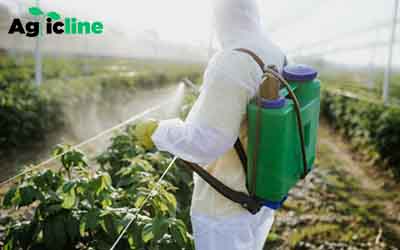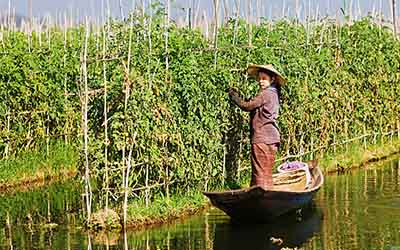Shifting cultivation is often synonymous with slash-and-burn agriculture, it is a farming method that has been practiced for millennia across various parts of the world.
This agricultural technique is particularly prevalent in the tropical rainforests of South America, Africa, and Southeast Asia.
At its core, shifting cultivation involves the temporary clearing of forested land to grow crops, after which the land is left fallow to regenerate and recover its fertility.
This cycle, which can vary from a few years to several decades, is a testament to the adaptability and sustainability of traditional agricultural practices.
The importance of shifting cultivation extends far beyond its role in food production.
It is deeply intertwined with the cultural and social fabric of many indigenous and rural communities, serving as a pillar of their livelihoods, traditions, and connection to the land.
What are the examples of Shifting Cultivation?
A classic example of shifting cultivation can be found in the Amazon Basin, where indigenous tribes have practiced this form of agriculture for centuries.
By clearing small patches of the rainforest, these communities grow crops like cassava, maize, and plantains.
After a few years of harvests, when soil fertility declines and weed invasion becomes problematic, they move to a new patch, allowing the forest to reclaim the old one.
Where is Shifting Cultivation Practiced?
Shifting cultivation is predominantly practiced in the tropical rainforests of South America, Central and West Africa, Southeast Asia, and the Pacific Islands.
These regions share a common trait: they’re all located within the equatorial belt, where the climate and ecological conditions are suitable for this type of farming.
What are the Effects of Shifting Cultivation?
Shifting cultivation impacts both the environment and local communities. Positively, it supports biodiversity through its cyclical nature, allowing areas to regenerate and wildlife to flourish.
It also helps preserve traditional lifestyles and knowledge systems. However, when not practiced sustainably, it can lead to deforestation, loss of biodiversity, and greenhouse gas emissions from burning vegetation.
What are crop in Shifting Cultivation?
The choice of crops in shifting cultivation is largely influenced by local climate and soil fertility.
Commonly grown crops include root crops like yams and cassava, grains such as rice and millet, and various vegetables and fruits.
These crops are selected for their adaptability to the harsh conditions of newly cleared forest areas.

Shifting Cultivation Climate
Shifting cultivation is closely tied to tropical climates, characterized by high temperatures and abundant rainfall.
These conditions are ideal for rapid biomass growth, which is crucial for the slash-and-burn technique to be effective.
The climate also influences the fallow period necessary for land to regenerate before it can be cultivated again.
What is Shifting Cultivation?
Shifting cultivation begins with the clearing of a forested area, usually by cutting and burning the vegetation, which adds nutrients to the soil in the form of ash.
This technique, often referred to as slash-and-burn agriculture, prepares the land for the cultivation of crops.
After a few years of cultivation, when soil fertility declines and weeds become too burdensome, the land is left fallow.
During the fallow period, which can last for many years, the land recovers its fertility as the natural vegetation regrows and soil nutrients are replenished.
Historically, shifting cultivation has been an adaptive strategy that allowed communities to thrive in challenging environments.
It is a testament to human ingenuity in agriculture and has been practiced in various forms around the globe, especially in the Amazon Basin, Central and West Africa, and Southeast Asia.
The Cycle of Shifting Cultivation
The cycle of shifting cultivation is a dynamic process that involves several stages:
- Selection of the Site
- Clearing the Land
- Planting
- Harvesting
- Fallowing
Disadvantages of Shifting Cultivation
Despite its benefits, shifting cultivation faces criticism for several reasons. The primary concern is its contribution to deforestation, especially when fallow periods are shortened due to population pressure or economic demands.
This can lead to soil degradation, reduced biodiversity, and increased carbon emissions.
The Techniques of Shifting Cultivation
Shifting cultivation, a practice rooted in the ages, employs a variety of techniques that have been refined over generations.
These methods are not only about clearing land and growing crops but also involve a deep understanding of local ecosystems, crop diversity, and sustainable land management.
Land Preparation and Clearing Methods
The initial step in shifting cultivation involves selecting a plot of land, usually covered by natural forest or bush. The land is then cleared through a process known as slash-and-burn.
Vegetation is cut down and left to dry before being set on fire. The burning serves multiple purposes: it clears the land of heavy vegetation, releases nutrients stored in the biomass back into the soil, and reduces pest populations.
This method of land preparation creates a fertile ash layer that enhances soil productivity for the initial cultivation years.
Crop Selection and Diversity
Crop selection in shifting cultivation is highly diversified and tailored to local conditions. Farmers plant a mix of crops (polyculture) rather than a single crop (monoculture).
This diversity has several benefits: it reduces the risk of total crop failure, mitigates pest and disease outbreaks, and improves diet diversity.
Common crops include staples like rice, maize, and cassava, supplemented with vegetables, fruits, and legumes.
This approach to crop selection and diversity underscores the adaptability of shifting cultivators to their environment, ensuring food security and resilience.
Traditional Knowledge and Practices in Crop Rotation and Soil Fertility
Shifting cultivation is underpinned by an intricate understanding of traditional knowledge and practices, particularly in crop rotation and maintaining soil fertility.
Farmers choose crop sequences that optimize nutrient use and minimize soil depletion. Legumes, for example, are often incorporated into rotations to fix nitrogen in the soil, benefiting subsequent crops.
The fallow period, when the land is left to regenerate, is crucial. During this time, native vegetation reclaims the plot, preventing soil erosion, enhancing soil structure, and gradually restoring fertility.
The length of the fallow period depends on local ecological conditions but is critical for the sustainability of shifting cultivation.
The Role of Fallowing
Fallowing is a fundamental aspect of shifting cultivation, allowing ecosystems to recover and maintain their resilience.
During the fallow period, biodiversity is enhanced, and ecological processes restore the soil’s physical and chemical properties.
This period also supports wildlife and maintains ecological balance, showcasing the practice’s inherent respect for nature.
Environmental Impact of Shifting Cultivation
- Sustainability and Biodiversity
- Deforestation and Soil Degradation
- Carbon Emissions and Climate Change
- Adapting Shifting Cultivation for Environmental Sustainability
Sustainability and Biodiversity
Shifting cultivation, in its traditional form, promotes a mosaic of habitats, including various stages of forest regrowth, agriculture, and mature forests.
This diversity of landscapes can support a wide range of plant and animal species, contributing to high levels of biodiversity.
The practice of rotating fields and allowing long fallow periods for land to revert to forest can create a dynamic equilibrium, preserving forest cover over time and enabling a variety of species to thrive.
Deforestation and Soil Degradation
Criticism of shifting cultivation often focuses on its potential to drive deforestation and soil degradation, especially when fallow periods are shortened due to population pressure or when the land is converted to permanent agriculture or other uses.
In scenarios where land is not allowed sufficient time to regenerate, the continuous clearing of forest for new agricultural plots can lead to a significant loss of forest cover.
Carbon Emissions and Climate Change
Shifting cultivation has implications for global climate change, primarily through the release of carbon stored in trees and soil into the atmosphere.
When vegetation is burned to clear land, significant amounts of carbon dioxide are released, contributing to greenhouse gas emissions.
However, the impact of shifting cultivation on carbon emissions is complex and depends on the balance between carbon released during land clearing and carbon sequestered during the fallow periods.
In long-cycle shifting cultivation, where fallow periods are sufficiently long for forests to regrow, the practice can be relatively carbon-neutral.
The Socioeconomic Role of Shifting Cultivation
- Livelihood Support and Food Security
- Economic Stability and Resource Management
- Cultural Identity and Traditional Knowledge
Shifting Cultivation and Climate Change
Shifting cultivation, a practice deeply intertwined with the livelihoods and cultures of many indigenous and rural communities, finds itself at the crossroads of global climate change debates.
This traditional agricultural method, characterized by its cyclical pattern of clearing, cultivating, and then leaving land fallow, has both been affected by and contributes to climate change in various ways.
Climate change poses significant challenges to the sustainability of shifting cultivation.
Changes in rainfall patterns, temperature increases, and the frequency of extreme weather events can disrupt the delicate balance of shifting cultivation systems.
For instance, altered precipitation regimes can affect crop growth cycles and reduce yields, while increased temperatures may lead to the expansion of pests and diseases, further threatening food security.
Contribution to Climate Change
Shifting cultivation contributes to climate change primarily through the emissions of greenhouse gases resulting from the burning of vegetation to clear fields.
This practice releases carbon stored in forests into the atmosphere, contributing to global warming.
However, the overall impact of shifting cultivation on climate change is complex and varies greatly depending on the length of the fallow periods, the scale of the practice, and the specific management techniques employed.
In systems where long fallow periods allow for the regrowth of forests, carbon sequestration during the regrowth phase can partially or fully offset the emissions from clearing and burning, potentially making these systems carbon-neutral over time.
Adaptive Strategies
Adapting shifting cultivation to the realities of climate change involves enhancing its resilience and reducing its environmental footprint. Strategies include:
- Diversifying crops
- Shortening fallow periods through improved agricultural practices
- Incorporating sustainable land management practices

Conclusion remark on shifting cultivation and its disadvantages
Shifting cultivation encapsulates a complex balance between human needs and ecological stewardship.
It serves not only as a means of livelihood for millions but also as a testament to the resilience and ingenuity of traditional agricultural practices.
However, as we’ve learnt, this balance is increasingly threatened by modern pressures, including deforestation, climate change, and policy constraints, which challenge the sustainability of shifting cultivation.
By valuing traditional knowledge, supporting adaptive practices, and ensuring policy frameworks that protect and promote shifting cultivation within sustainable limits, we can ensure that this ancient practice continues to contribute to biodiversity, food security, and the cultural heritage of rural and indigenous communities around the globe.
Recommendations
Understanding floating gardens Aztecs
How to get rid of varroa mites naturally
7 Best Methods of pest control in agriculture
How To Become An Agriculturist



